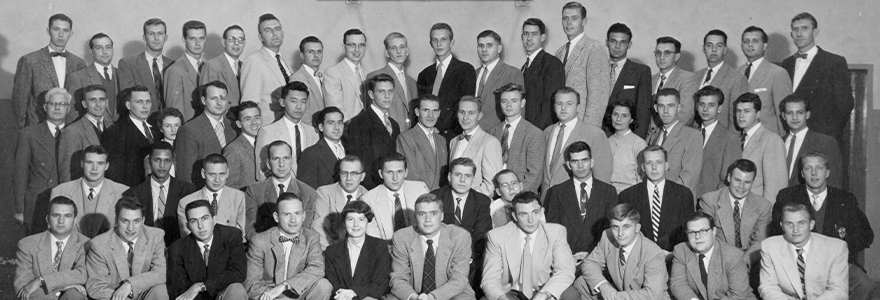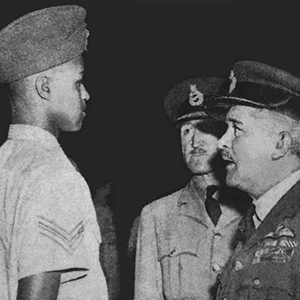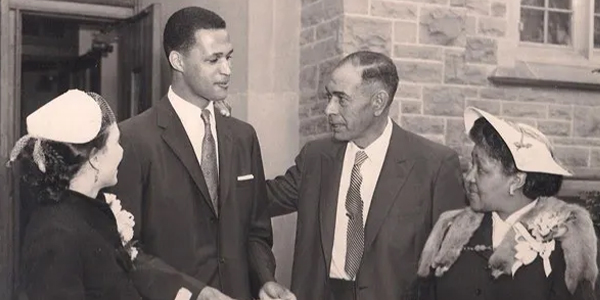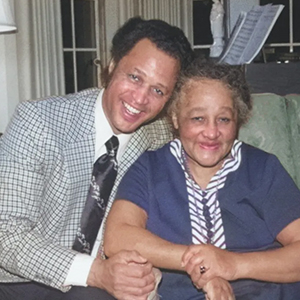Honouring the legacy of Western’s first Black medical graduate
 The Class of 1957, third-year photo. Milburn is in the second row, second from left. (Western Archives).
The Class of 1957, third-year photo. Milburn is in the second row, second from left. (Western Archives).
By Prabhjot Sohal
Dr. Lewis H. Milburn lived both his dreams, to serve in the military and be a doctor, inspiring future generations
In 1947, a young Black Canadian air cadet of the Windsor Squadron named Lewis H. Milburn met Air Marshal William Avery “Billy” Bishop during one of the legendary flying ace’s appearances at a Canadian Air Force event in southwestern Ontario. Struck by the young cadet’s enthusiasm, Bishop asked Milburn if he wanted to become an air force pilot. The 17-year-old said yes and added that he also wanted to be a doctor. Bishop told him he could become a flight surgeon and be both.
This encounter marked a turning point in Milburn's life. His dream to excel in medicine and the military gave him a goal. Bishop took him under his wing with a promise to build a path for his success.
Milburn, a descendant of the Underground Railroad families of southwestern Ontario, became the first Black medical student to graduate from Western in 1957. Dr. Milburn later joined the U.S. Air Force as the first Black Canadian flight surgeon and rose to become the deputy director of aerospace medicine at the U.S. Air Force.
 Air cadet Lewis H. Milburn, 17, meeting Air Marshal William Avery “Billy” Bishop in 1947.
Air cadet Lewis H. Milburn, 17, meeting Air Marshal William Avery “Billy” Bishop in 1947.
Sowing the seeds of a dream
Although Milburn had found a mentor early in life, the road to success wasn’t without challenges.
Growing up in Windsor, Ont., during the post-Second World War boom, Milburn was keenly watching the rapid advancements in science and technology. While he was holding onto his two ambitious dreams, the Milburn family – no strangers to the shattering of hopes in a society still divided along racial lines – was preparing him for the long haul.
Milburn’s son David, who now lives in Detroit, has been documenting the history of the family, friends and the community that loved and supported his father.
“Our ancestors were among the first Black people who came via the Underground Railroad network to settle in Canada. They had close interactions with Indigenous peoples and even fought alongside Chief Tecumseh in the War of 1812,” said David.
Lewis Milburn’s father, Louis B. Milburn, was the director of maintenance engineering at the Windsor Board of Education and his mother, Geneva Cross-Milburn, was the first person of colour to become a delegate of the Progressive Conservative party.
“My grandparents knew rights had to be fought for. And that to succeed as a person of colour their son had to not only be the best but also have a network of support,” said David. “They worked hard towards building those connections for him early on and kept dad focused, helping him hone language, math, and science skills.”
Journey to medical school
After graduating from high school – the Patterson Collegiate Institute in Windsor – Milburn followed his high school sweetheart, Ada Thompson, to Montreal, where he enrolled at McGill University.
“My mother’s family moved to Montreal and that’s why dad joined McGill – to be with her,” laughed David, remembering Milburn’s love for his wife.
After graduating from McGill with a bachelor of science degree, Milburn married Ada, and set his eyes on medical school admissions.
“Western was a top medical school. Dad also wanted to move closer to his family in Windsor, so Western was his number one choice,” said David.
 Dr. Lewis H. Milburn with wife, Ada Thompson-Milburn; mother, Geneva Cross-Milburn.
Dr. Lewis H. Milburn with wife, Ada Thompson-Milburn; mother, Geneva Cross-Milburn.
Milburn flourished in medical school. “My father was a brilliant student and helped his fellow medical students with classes. He was even invited to join an exclusive international fraternity, but his admission to it was denied by the fraternity’s home office due to his race,” said David. This incident brought home to his fellow students the level of prejudice and racism that Milburn had to face and overcome. “They respected him even more.”
David shared that his mother worked several jobs to keep his father in medical school and the family together.
“Dad was very dedicated to his work. He wanted to be at the top of the class. Being the first person of colour in the medical school, he wanted to be a role model for others.”
Cementing the Milburn legacy
David remembers his father telling him that Billy Bishop, who passed away in 1959, had contacted the aerospace program run by the U.S. Air Force and the National Aeronautics and Space Administration (NASA) and had set up recruitment for Milburn. “They would recruit only the top graduates. Dad graduated with honours and made the cut. At that time, they were recruiting in aerospace medicine for NASA and he was a good match,” said David.
Milburn served with the U.S. Air Force and NASA for 12 years. During this time, he formed a close friendship with USAF pilot Edward J. Dwight, Jr., the first African-American to be trained as an astronaut at NASA.
“Dad was also stationed overseas in Spain, Germany and Japan. The people he met were always very impressed. He represented Canada very well,” said David, adding Milburn always identified himself as a Canadian. “He was 6’5” tall with a striking presence. While he held very high standards, he was a very warm person. People saw in him qualities that were different – in a good way.”
 Dr. Lewis Milburn with his mother, Geneva Cross- Milburn.
Dr. Lewis Milburn with his mother, Geneva Cross- Milburn.
After leaving military service, Milburn continued to practice medicine in Detroit. Board certified in psychiatry and neurology, Milburn inspired many young people of colour to join medicine, including David and his niece Dr. Lauren McCurdy, former director of breast imaging at St. Joseph’s Hospital in London, Ont.
David shared that when he went to medical school, he saw more diversity in his classroom than what his father had encountered during his time at Western. “A lot has improved, but a lot still needs to be done."
Milburn passed away on February 4, 1992, at the age of 63 in Detroit. He is survived by his wife Ada and sons David and Brent.
“It was a huge funeral that brought people together from all walks of life. We had crossed the bridge from Detroit to Windsor – his final resting place. The crowd was so large, they had to close down the bridge,” said David.
David maintains a website dedicated to Milburn’s legacy and the history of the Underground Railroad families in southern Ontario.









